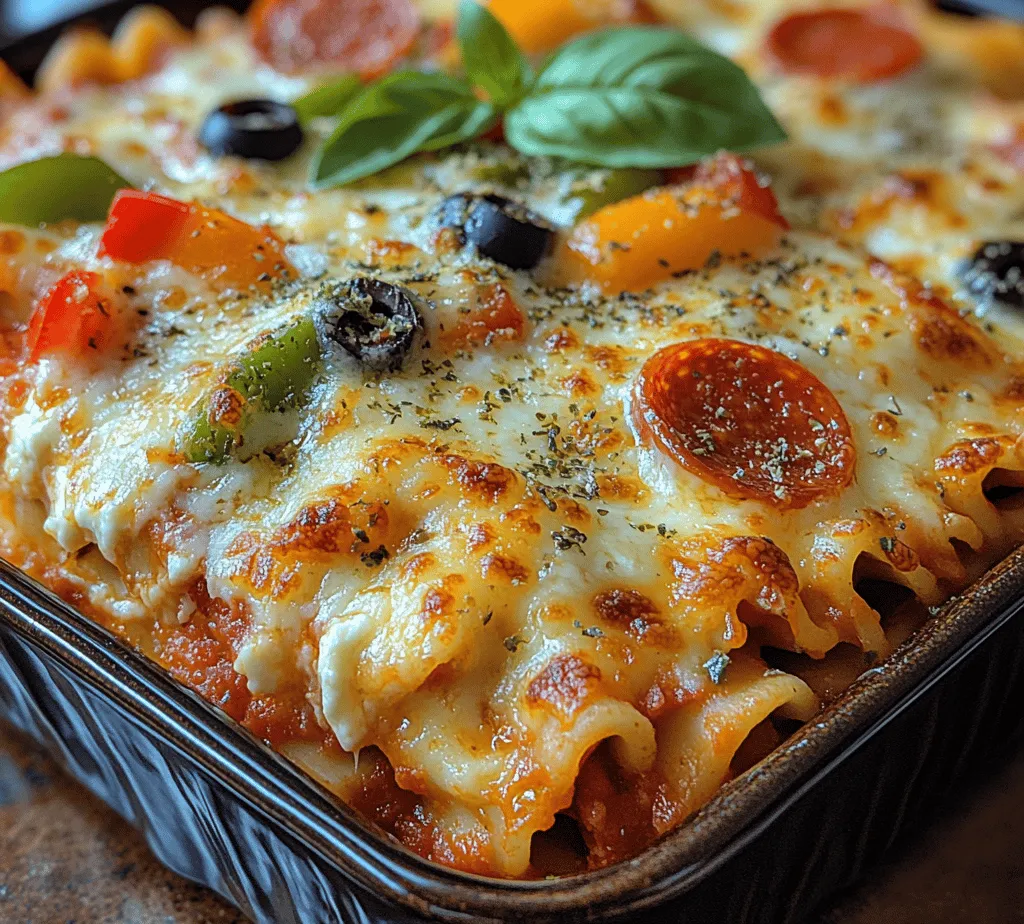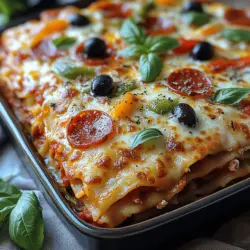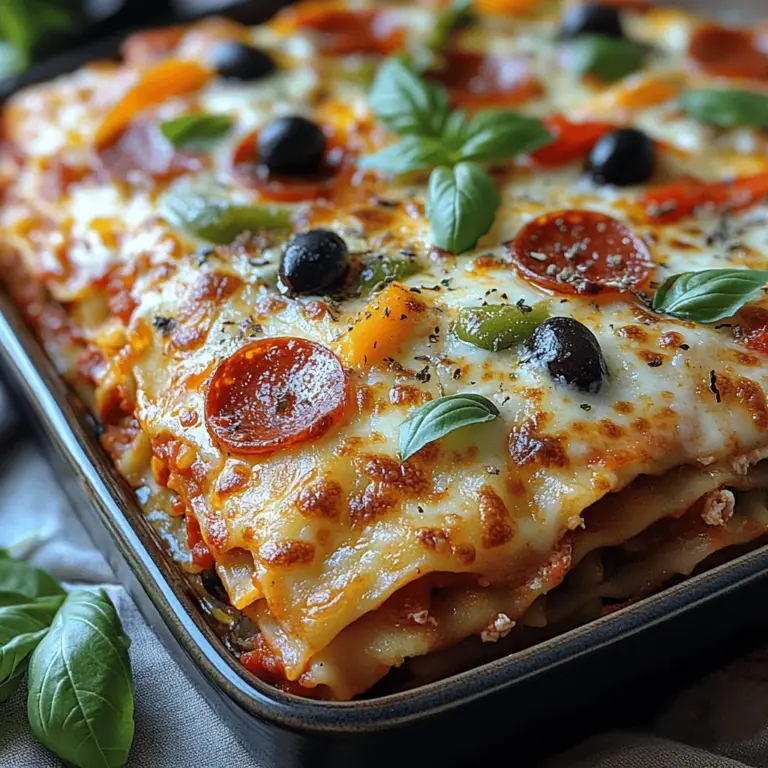In the world of comfort food, few dishes stand out quite like pizza lasagna. This delightful recipe marries the beloved layers of traditional lasagna with the classic flavors of pizza, creating a hearty meal that’s perfect for family gatherings, weeknight dinners, or special occasions. Imagine layers of tender noodles, savory marinara sauce, creamy ricotta, and a blend of cheeses, all topped with your favorite pizza toppings. This dish is not only visually appealing but also incredibly satisfying, making it a go-to option for feeding a crowd or simply indulging yourself after a long day.
Pizza lasagna is the answer for those who can never decide between pizza and pasta; it elegantly combines the best of both worlds. Whether you’re a fan of pepperoni, a vegetarian looking for a hearty meal, or someone who enjoys experimenting with unique flavors, pizza lasagna can be tailored to suit your taste. In this article, we’ll explore the ingredients, preparation steps, and various tips to ensure your pizza lasagna is a hit every time.
Understanding the Key Ingredients
Creating the perfect pizza lasagna starts with selecting high-quality ingredients that will enhance the dish’s overall flavor and texture. Let’s delve into each key component that makes this dish truly special.
Lasagna Noodles: The Foundation of Your Dish
The noodles you choose for your pizza lasagna will set the stage for the dish. You can opt for traditional lasagna noodles or go for no-boil varieties, which offer convenience without sacrificing flavor.
– Regular Lasagna Noodles: If you choose traditional noodles, you’ll need to boil them until al dente before assembling your lasagna. This method ensures that the noodles are cooked through and will hold their shape during baking. When boiling, be sure to add a pinch of salt to the water for flavor and avoid overcooking, as they will continue to cook in the oven.
– No-Boil Lasagna Noodles: These noodles are pre-cooked and can be layered directly into the dish, saving you time and effort. Just be mindful that they require a bit more sauce to ensure they cook properly while baking.
Whichever type you choose, ensure the noodles are of high quality, as they serve as the foundation of your pizza lasagna.
Marinara Sauce: The Flavor Base
The sauce plays a critical role in defining the flavor profile of your pizza lasagna. You have the option of making your own marinara sauce or using store-bought varieties, both of which can yield delicious results.
– Homemade Marinara: If you’re inclined to make your own, a simple marinara sauce can be made by sautéing garlic and onions in olive oil, then adding crushed tomatoes, herbs like basil and oregano, and a pinch of salt. Let it simmer to develop the flavors. Homemade sauce allows you to control the seasoning and adjust it to your taste.
– Store-Bought Marinara: For those short on time, store-bought marinara can be a lifesaver. To elevate the flavor, consider enhancing it with dried herbs, a splash of red wine, or even a pinch of red pepper flakes for some heat. This small addition can significantly improve the overall taste.
The choice of marinara influences the final dish, so select a sauce that resonates with your taste preferences.
Cheese Selection: Creamy and Cheesy Layers
Cheese is a defining element of pizza lasagna, contributing creaminess and flavor. The combination of cheeses used can make or break your dish.
– Ricotta Cheese: This cheese is essential for providing a creamy texture that complements the other ingredients. When mixing ricotta, consider adding an egg to provide structure and prevent the cheese from becoming too watery during baking. You can also incorporate fresh herbs like parsley or basil for added flavor.
– Mozzarella Cheese: No pizza lasagna is complete without mozzarella. Its melting qualities and mild flavor make it a perfect choice for layering. For a gooey experience, opt for whole-milk mozzarella or a blend of mozzarella and provolone.
– Parmesan Cheese: Adding freshly grated Parmesan will enhance the dish with a salty, nutty flavor. Sprinkle it between the layers and on top for a crispy, golden finish.
Choosing the right combination of cheeses will create a rich and satisfying experience in every bite.
Toppings: Personalizing Your Pizza Lasagna
One of the most exciting aspects of pizza lasagna is the opportunity to personalize it with your favorite toppings. The options are virtually limitless, which allows you to cater to different tastes and dietary preferences.
– Traditional Toppings: Classic pizza toppings such as pepperoni, sausage, bell peppers, mushrooms, and olives can be layered between the noodles for a familiar flavor profile. For meat lovers, a combination of ground beef and Italian sausage can create a hearty filling.
– Vegetarian Options: For a lighter version, consider using a medley of vegetables like zucchini, spinach, and artichokes. Roasted vegetables can also add depth of flavor and a touch of sweetness.
– Unique Toppings: Don’t be afraid to experiment with unique toppings. Consider using barbecue chicken, buffalo sauce, or even a mix of different cheeses to create a gourmet twist on pizza lasagna.
The choice of toppings allows for creativity and personalization, making this dish an excellent option for gatherings where guests may have varying tastes.
Step-by-Step Preparation of Pizza Lasagna
With the ingredients in hand, it’s time to dive into the preparation of your pizza lasagna. The following steps will guide you through the process, ensuring a successful and delicious outcome.
Prepping the Oven and Ingredients
Before you begin assembling your pizza lasagna, it’s essential to prepare your workspace and ingredients.
1. Preheat the Oven: Preheating your oven to 375°F (190°C) is crucial for even cooking. A properly heated oven ensures that your lasagna bakes uniformly, resulting in a melty cheese top and perfectly cooked noodles.
2. Ingredient Preparation: Take the time to prepare all your ingredients before assembly. Cook any meats if using, slice vegetables, and measure out your cheeses and sauces. This prep work will streamline the layering process and make it easier to create your dish.
Assembling the Layers: The Heart of Lasagna Creation
Now comes the fun part—layering your ingredients to create a harmonious blend of flavors and textures. Follow these steps to assemble your pizza lasagna:
1. Start with Sauce: Begin by spreading a thin layer of marinara sauce at the bottom of your baking dish. This will prevent the noodles from sticking and ensure they are infused with flavor.
2. Layer the Noodles: Place your first layer of lasagna noodles over the sauce. If using regular noodles, ensure they overlap slightly but do not cover each other completely.
3. Add Ricotta: Dollop ricotta cheese over the noodles and spread it evenly. This creamy layer adds richness and helps bind the layers together.
4. Sprinkle Cheese and Toppings: Next, add a layer of shredded mozzarella cheese, followed by a generous sprinkle of Parmesan. Then, layer your choice of pizza toppings, ensuring an even distribution.
5. Repeat the Layers: Continue layering in the same order: sauce, noodles, ricotta, mozzarella, toppings, until you run out of ingredients, finishing with a layer of noodles topped with sauce and cheese.
6. Balance of Flavors: Pay attention to the balance of flavors and textures with each layer. Aim for an even distribution of sauce, cheese, and toppings to ensure every bite is delicious.
Baking to Perfection: Achieving Golden Cheese
Once your pizza lasagna is assembled, it’s time to bake it to perfection.
1. Cover and Bake: Cover the dish with aluminum foil to prevent excessive browning. Bake in the preheated oven for about 30 minutes.
2. Uncover and Brown: After 30 minutes, remove the foil and continue baking for an additional 15-20 minutes, or until the cheese is bubbly and golden brown.
3. Cooling Time: Once baked, allow the lasagna to cool for at least 10-15 minutes before slicing. This cooling period helps the layers set, making it easier to serve.
By following these steps, you’ll create a pizza lasagna that is not only visually appealing but also bursting with flavors that everyone will love. With its unique combination of pizza and lasagna elements, this dish promises to become a favorite in your household. Stay tuned as we continue with tips for best results and answer some common questions about this delectable dish.

Baking Times and Temperatures
When it comes to baking your pizza lasagna to perfection, the right time and temperature are crucial. Preheat your oven to 375°F (190°C). This temperature allows the layers to cook evenly without burning the top layer of cheese.
Typically, your pizza lasagna will need to bake for about 45 minutes to 1 hour. The exact time can vary based on the thickness of your layers and the specific ingredients you use. For instance, if you’re using a lot of fresh vegetables, these can release moisture, possibly extending your cooking time slightly.
To ensure that your pizza lasagna is cooked through, it’s essential to keep an eye on the cheese. It should be bubbly and golden brown, creating an inviting crust that signals the dish is ready.
How to Tell When Your Pizza Lasagna is Perfectly Cooked
To confirm that your pizza lasagna is perfectly cooked, there are a few indicators you can rely on:
1. Visual Cues: The cheese on top should be melted and lightly browned. The edges may also bubble, and you might see steam escaping from the sides.
2. Texture Test: Using a sharp knife or a fork, gently press down on the center of the lasagna. If it feels firm and the layers hold together without being overly mushy, it’s a good sign that it’s ready.
3. Thermometer Check: For an extra measure of assurance, you can use a kitchen thermometer. The internal temperature should reach at least 165°F (74°C) to ensure that all ingredients are properly cooked and safe to eat.
Allowing to Rest: Importance of Cooling Time
Once your pizza lasagna has finished baking, resist the urge to dive right in. Allowing it to rest for at least 15-20 minutes before serving is crucial. This cooling time lets the layers set, making it easier to cut and serve. If you cut into it too soon, you risk having the layers slip apart and create a mess on your plates.
Moreover, resting allows the flavors to meld together, enhancing the overall taste of your dish. The longer you can wait, the better it will be, but 15-20 minutes is typically sufficient for optimal results.
Garnishing for Visual Appeal
Presentation plays a significant role in how a dish is received. For your pizza lasagna, consider garnishing with fresh basil or parsley. These herbs not only add a pop of color but also introduce a fresh flavor that complements the rich ingredients in the lasagna.
For a more visual delight, you can sprinkle some grated Parmesan or a drizzle of balsamic reduction on top just before serving. This adds a gourmet touch that will impress your guests and elevate the overall dining experience.
When plating your pizza lasagna, use a large spatula to cut out a square piece, making sure to scoop underneath each layer to keep it intact. Serve with a side salad or garlic bread for a complete meal.
Variations on Pizza Lasagna
Vegetarian Options
For those who prefer a meatless meal, creating a vegetarian pizza lasagna is simple and satisfying. Substitute the meat with a variety of vegetables such as zucchini, spinach, bell peppers, and mushrooms.
You can also use plant-based cheese alternatives, which melt beautifully and offer a creamy texture. Consider adding a layer of pesto or a homemade marinara sauce enriched with vegetables for an extra flavor boost.
Gluten-Free Adaptations
If you or your guests require gluten-free options, you can easily adapt this recipe. Look for gluten-free lasagna noodles available in most grocery stores. Additionally, ensure that your sauces—both marinara and any cheese sauces—are certified gluten-free.
This version maintains the deliciousness of traditional pizza lasagna while accommodating dietary restrictions.
Freezing and Reheating
Pizza lasagna freezes exceptionally well, making it a great meal prep option. To freeze, allow the lasagna to cool completely, then wrap it tightly in plastic wrap followed by aluminum foil, or place it in an airtight freezer-safe container. It can last for up to 3 months in the freezer.
When you’re ready to enjoy your frozen pizza lasagna, remove it from the freezer and let it thaw in the refrigerator overnight. Bake it at 375°F (190°C) for about 30-40 minutes until heated through. You may want to cover it with foil during the first half of the reheating process to prevent the cheese from burning.
Nutritional Breakdown of Pizza Lasagna
Caloric Content and Portion Control
Understanding the nutritional profile of your pizza lasagna can help you enjoy it guilt-free. A standard serving (about one-eighth of the lasagna) typically contains around 350-450 calories, depending on the specific ingredients used.
This dish provides a balanced mix of carbohydrates from the noodles, protein from the cheese and meat (if included), and vitamins and minerals from the vegetables. To maintain a healthy balance, consider portion control, serving it alongside a salad or steamed vegetables to complement the meal.
Healthier Ingredient Swaps
If you’re looking to reduce calories while still savoring all the flavors of pizza lasagna, consider these healthier ingredient swaps:
– Use Low-Fat Cheese: Opt for reduced-fat mozzarella or ricotta cheese to cut down on calories without sacrificing taste.
– Whole Grain Noodles: Switching to whole grain or whole wheat lasagna noodles boosts fiber content and adds more nutrients.
– Increase Vegetables: Load up on vegetables to add volume and nutrients while keeping calories in check. Vegetables such as spinach, kale, and bell peppers not only enhance the flavor but also provide essential vitamins and minerals.
Conclusion: Enjoying Your Homemade Pizza Lasagna
Pizza lasagna is more than just a meal; it’s an experience that brings people together around the dinner table. With its rich flavors and comforting textures, this dish is sure to become a family favorite. By following the steps outlined in this article, you can create a delicious and satisfying pizza lasagna that showcases your cooking skills and creativity.
Whether you stick to the classic recipe or experiment with your own toppings, the joy of sharing this meal with loved ones is what truly makes it special. Enjoy every layer of this delightful dish, and let it spark conversations and create memories around your table.

